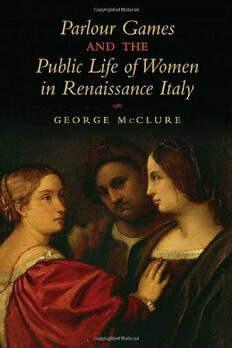
Parlour Games and the Public Life of Women in Renaissance Italy PDF
Preview Parlour Games and the Public Life of Women in Renaissance Italy
PARLOUR GAMES AND THE PUBLIC LIFE OF WOMEN IN RENAISSANCE ITALY This page intentionally left blank GEORGE McCLURE Parlour Games and the Public Life of Women in Renaissance Italy UNIVERSITY OF TORONTO PRESS Toronto Buff alo London © University of Toronto Press 2013 Toronto Buff alo London www.utppublishing.com Printed in Canada ISBN 978-1-4426-4659-9 Printed on acid-free, 100% post-consumer recycled paper with vegetable- based inks. Library and Archives Canada Cataloguing in Publication McClure, George W., 1951– Parlour games and the public life of women in Renaissance Italy / George McClure. Includes bibliographical references and index. ISBN 978-1-4426-4659-9 1. Women – Italy – Social life and customs – 16th century. 2. Women – Italy – Intellectual life – 16th century. 3. Women – Italy – History – Renaissance, 1450–1600. 4. Indoor games – Social aspects – Italy – History – 16th century. 5. Renaissance – Italy. 6. Italy – Social life and customs – 16th century. I. Title. hq1149.i8m34 2013 305.4094509'031 c2012-908140-X University of Toronto Press acknowledges the fi nancial assistance to its publishing program of the Canada Council for the Arts and the Ontario Arts Council. University of Toronto Press acknowledges the fi nancial support of the Government of Canada through the Canada Book Fund for its publishing activities. Contents Illustrations vii Preface ix 1 The Renaissance Theory of Play 3 2 The Academy of the Intronati and Sienese Women (1525–1555) 29 3 The Games of Girolamo and Scipione Bargagli (1563–1569) 55 4 Fortunes, Medals, Emblems: The Public Face of Private Women 81 5 The Birth of the Assicurate: Italy’s First Female Academy (1654–1704) 119 6 Girolamo Gigli: The Legacy of the Sienese Games and Sienese Women 159 Conclusion 182 Notes 199 Bibliography 287 Index 307 This page intentionally left blank Illustrations 1.1 The Game of Happiness and Goods 16 4.1 Fortune for Elena Tolomei 98 4.2 Fortune for Livia Marzi 100 4.3 Fortune for Sulpitia Pannilini de’ Placidi 102 4.4 Fortune for Flavia Bellanti 103 4.5 Emblem of an Unnamed “Young Lady” 106 4.6 Emblem of Girolama Petrucci 111 4.7 Emblem of Fulvia Spannocchi de’ Sergardi 112 4.8 Emblem of Leonora Montalvi degli Agostini 114 4.9 Emblem for an Unnamed Woman 115 4.10 Emblem for an Unnamed Widow 117 5.1 Title Page of the Academy Book of the Assicurate 127 5.2 Emblem of the Academy of the Assicurate 128 5.3 Founding of the Academy of the Assicurate 129 5.4 Roster of Members of the Academy of the Assicurate 131 5.5 Title Page of “Accounts . . . of Giuochi di Spirito Performed in Siena at Various Times” 134 5.6 Party of 1664, from “Accounts . . . of Giuochi di Spirito Performed in Siena at Various Times” 138 5.7 Party of October 1664, Lucrezia Santi Bandinelli’s Introduction to Giulia Turamini’s lecture “Concerning the Excellence of Women Over Men” at a Party of June 1691 140 5.8 Title Page of Sole Assicurate Publication, Poesie per Musica 155 6.1 Roster of Assicurate Members 180 This page intentionally left blank Preface Rejoice, Ladies of the Assicurate, that through a pastime you can make war on time, and through play you can acquire immortality. With the spirited fearlessness of your wits this evening you can open up for yourselves a passage to glory. Do not be frightened of the heroic majesty that . . . will give you courage to make public those virtues that until now you have kept hidden under the silence of a rigorous modesty. (BCI, C.VIII.26, fol. 58r) So was recorded the speech of a Sienese woman to her colleagues in the all-female Academy of the Assicurate (the Assured) during a spirited parlour game in 1664. Parlour games involving both men and women emerged as a distinctive institution and literary genre in Italian Renais- sance culture. Especially when moving beyond the confi nes of the court, such revels constituted a new social space. Somewhere between the fully public male contests (e.g., tournaments) and fully private games in women’s quarters, parlour games – occurring in the public room of the private home among mixed company – comprised a playing and viewing public that aff orded a novel venue for discourse on a variety of literary, social, and political issues. They also refl ected a new cul- tural zone somewhere between learned and popular culture – whether “lowering” learned thought to a vernacular idiom or “elevating” oral culture (such as proverbs) to the realm of intellectual debate. What do these games tell us about the interactions of men and women? What do the structure and content of the games reveal about the intellectual and cultural life of polite, festive society? How do these games both refl ect social realities in some ways and challenge them in others? Operating in a temporary world on the margins of traditional hierarchies, such
